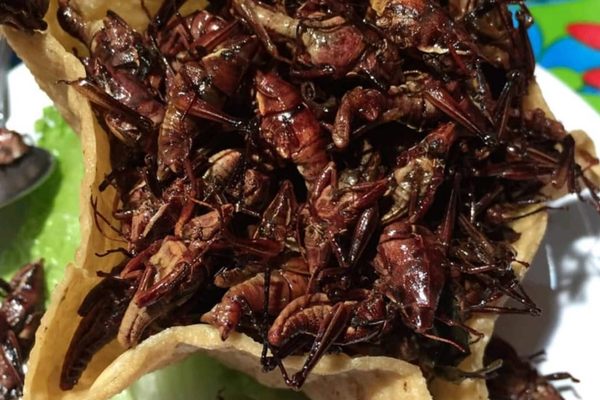Meats & Animal Products
Maguey Worm
This protein-rich legacy of the Aztecs makes for a savory taco filling.
The maguey worm is not actually a worm, but a caterpillar. And if you know your tequila, you know the agave plant, or maguey (pronounced “mah-GAY”), where these caterpillars make their home. Both white and red maguey worms are among the most prestigious insects consumed in Mexico and were once a vital source of protein for the Aztecs. Today, they make crispy, fried snacks and succulent taco fillings.
The red and white worms are actually two different species that both begin their lives as larvae on the agave plant. If left to mature, the white worm would become a Tequila Giant-Skipper butterfly, while the red variety would grow into a Comadia redtenbacheri moth. But the larvae’s journey is cut short by harvesters who roam the countryside in Mexico’s central states, scouring for signs of the worms’ presence on the plants. They then sell their larvae loot at local markets, where strings of dried maguey worms hang like necklaces from stalls and overflow from baskets. Some worms even make their way into restaurants in Mexico City, where high-end interpretations of the humble dish can cost as much as $30.
Chefs make the most of the maguey worms’ nutty taste—sometimes compared to fried pork “cracklings”—using them to add flavor to mole, texture to rice soup, and a savory pop to tacos served in warm tortillas with guacamole. For those who might not be ready to consume a whole critter, a smoky powder made from ground-up worms, salt, and red chile (sal de gusano) serves as a seasoning and a favorite pairing with slices of lime and mezcal.
Wondering about the worm at the bottom of your tequila? That’s usually the red maguey worm, which found its way into the bottle in the mid-20th century as a marketing ploy for selling mediocre booze.
Where to Try It
-
Mercado 20 de Noviembre
20 de noviembre 512, Centro, Oaxaca, 680000, MexicoIn the heart of a region where maguey worms are harvested, find them at this market fresh, dried, and fried.
-
Corazón de Maguey
Plaza Centenario, 9, Coyoacán, Mexico City, 04000, MexicoIf you want to enjoy maguey worms in high fashion, find them, and other traditional dishes, at this colorful restaurant.
Written By
 Leigh ChavezBush
Leigh ChavezBush
Sources
- pdfs.semanticscholar.org/9fdb/2ff883e0226e78bbca2f01f759f990ea82f6.pdf
- www.fondazioneslowfood.com/en/ark-of-taste-slow-food/maguey-gusano-blanco/
- www.bioone.org/doi/full/10.2993/0278-0771-31.1.150
- www.gastroactitud.com/pista/festin-de-insectos-y-mezcal-en-corazon-de-maguey-mexico/
- books.google.com/books?id=hKVbCgAAQBAJ
- www.ncbi.nlm.nih.gov/pubmed/27436292
- articles.latimes.com/1993-03-28/news/mn-16164_1_aztecs-mexicans-cuisine
- books.google.com/books?id=WaEyJ9zWZDgC&pg=PT81&lpg=PT81&dq=aztecs+and+maguey+worms&source=bl&ots=AibMXJs7K9&sig=oI0Jctph5II2Cs0PN-3l60HAW90&hl=en&sa=X&ved=0ahUKEwirguSe5IjcAhWvs1kKHZmDD74Q6AEIfzAM#v=onepage&q=aztecs%20and%20maguey%20worms&f=false

















